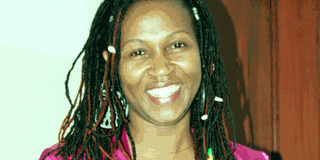Prime
Dreadlocks: No longer dreadful

Tina Musiya, the executive director at Centre for Domestic Violence Prevention, rocks locked hair, complimented with colour, beads and shells. Today, locks are worn by many irrespective of age or profession. Photo by Abubaker Lubowa.
What you need to know:
Some years back, the hairstyle was regarded as that for Rastafarians or unruly youth. Now, many more people are beginning to adopt it, especially women.
At the first Women in the Neurosciences conference I couldn’t help but notice the dreadlocked heads in the room, I counted five which was a quarter of the 20 or so people in the room. Even on the street, the sight of a matronly woman sporting dreadlocks is not uncommon. By all indications the style has come into its own as a hairstyle option for women as opposed to just being a statement trend.
The dreadlocks are no longer the trademark style of upcoming musicians or a drug taking rogue. From toddlers to women well over 40, to young church going men, the style has broken the belief that it is the mark of a rebel or an outward expression of the Rastafarian faith.
Enock Mbilizi, dreadlock stylist at Roy Beauty Parlour on Kimathi Street, agrees this style has gained popularity if the clients coming through his door are anything to go by. “Everyone is doing it, children, young people, women,” he says but notes the bulk of the clients who seek him for maintenance as well as those who seek to start wearing their hair in locks are women and at that the more mature ones.
So what’s the big attraction to “dreads” or “locks” as they are often referred to? Convenience and peace of mind, Mbilizi explains. “With locks, you do not have to fret about combing hair in the morning or carrying a comb during the day. Most women are drawn by this.” Dorothy Tuma, a business consultant who sports shoulder length dreadlocks, concurs, saying doing her hair in the morning has reduced to just gathering it into a ponytail.
Convenience aside there’s the growing number of women opting for a natural look and dreadlocks more than any other hairstyle combines staying natural and all important ease in looking after.
Besides being a great way to grow out hair, Mbilizi points that other women after years of struggling with weak or damaged hair see dreadlocks as salvation. Lucy, a sales executive, who says she had weak unyielding crop until she discovered dreadlocks, testifies. “With ‘locks’, my hair does not look as thin or harassed,” she says.
Dreadlocks look best on natural hair, meaning if you have it, you may have to cut off relaxed hair. But as Mbilizi explains, the difficulty of starting out again is rewarded by the all-natural, hassle free convenience of full grown dreadlocks. When this may happen is dependent on how fast your hair grows. If you are lucky like Tuma, you will get to the stage where maintenance becomes a DIY job.
For those who want to try but are not sure about the commitment (you only get out of them by cutting them off), there is always the choice of temporary dreadlocks.
This as Mbilizi explains is done the same way as permanent locks except you wash them off before the stands actually lock, usually after several weeks. “It is a nice way to test it out before deciding once and for all,” he says. Otherwise dreadlocks can be styled in various ways; braided, even plaited to accommodate a weave on.
The numbers:
80,000
The average price in shillings one needs in order to have the dreadlock hairstyle done on their head.
60,000
The average price in shillings for twisting the hair when new growth appears, depending on how fast your hair grows.




